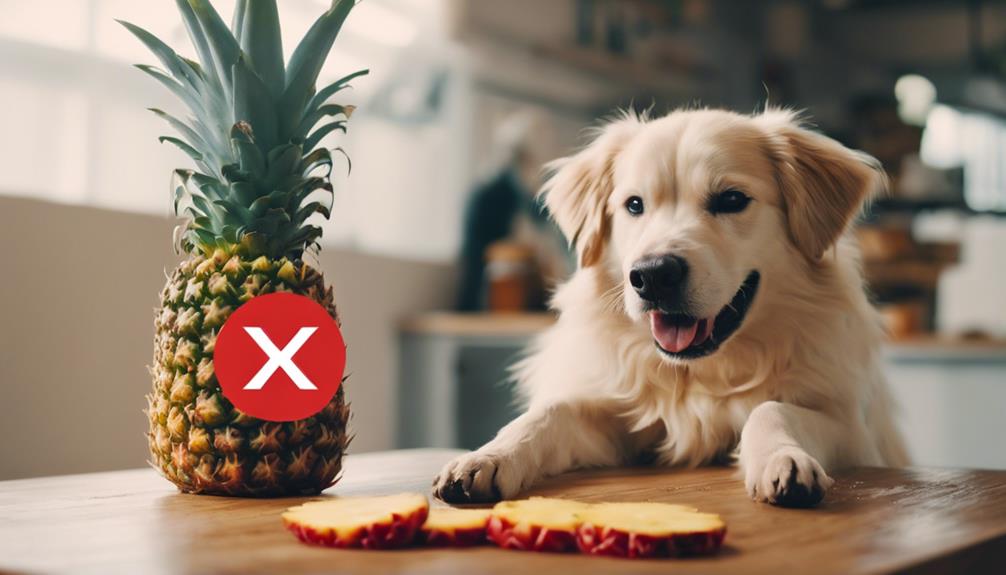Can Dogs Eat Pineapple
- Advertisement -
You can safely feed your dog fresh, raw pineapple in moderation, as it provides essential vitamins and minerals like vitamin C, potassium, and manganese. However, it's vital to follow proper feeding guidelines and precautions to avoid potential health risks. Remove the core and skin to prevent choking or blockages, and introduce small amounts to monitor for signs of allergy or upset stomach. Additionally, consult with a vet before adding pineapple to your dog's diet, especially if they have specific health conditions or allergies. By understanding the benefits and risks, you can make informed decisions about incorporating pineapple into your dog's nutrition plan, and there's more to learn about how to do it right.
Key Takeaways
- Fresh pineapple chunks are a healthy snack for dogs, rich in vitamins and minerals like vitamin C, potassium, and manganese.
- Only the soft inner fruit is safe for consumption, so remove the pineapple core and skin to avoid choking or blockages.
- Introduce small amounts (2-3 chunks) and monitor for signs of allergy or upset stomach, and consult with a vet before adding to a dog's diet.
- Pineapple should only make up 10% of a dog's overall diet, with the remaining 90% coming from well-balanced dog food to prevent digestive issues.
- Remove the core and rinds, and cut the pineapple into 1 inch x 1 inch x ½-inch thick pieces to prevent choking hazards or obstructions.
Types of Pineapple Safe for Dogs
Several types of pineapple are safe for dogs to eat. Fresh pineapple chunks are a healthy snack, rich in vitamins and minerals like vitamin C, potassium, and manganese. Raw pineapple is also safe and consists of 82% water, making it a nutritious treat. Pink pineapple, a genetically modified variety, is safe for dogs and provides the same nutritional benefits as regular pineapple.
Homemade dried pineapple can be a healthy treat if made without additives. However, avoid store-bought dried pineapple due to high sugar content.
When feeding your dog pineapple, avoid canned pineapple, which contains added sugars and preservatives that can harm your pet's digestive system. Always remove the core, as it can cause an intestinal blockage. Fresh pineapple chunks or raw pineapple are safe and healthy options. Introduce pineapple gradually to prevent digestive upset.
Incorporating pineapple into your dog's diet can provide a tasty and nutritious treat rich in fruits and vegetables. Prioritize your dog's health and consult with a veterinarian if you have any concerns.
Nutritional Benefits of Pineapple
Pineapple is a nutrient-dense fruit that provides essential vitamins and minerals for dogs. It's a rich source of vitamins, including vitamin C, thiamine, riboflavin, niacin, vitamin B6, and folate, which support immune system and digestive health.
Pineapple is also a good source of minerals like manganese, copper, potassium, magnesium, iron, calcium, phosphorus, and zinc. These minerals are vital for a dog's overall health and well-being. Vitamin C in pineapple boosts the immune system and reduces inflammation. Thiamine regulates energy and carbohydrate metabolism.
Manganese in pineapple is essential for bone health and development, as well as maintaining strong connective tissues. The antioxidants in pineapple, including flavonoids and bromelain, have anti-inflammatory properties that can reduce the risk of chronic diseases. Pineapple is also a good source of fiber, which supports healthy digestion and bowel function.
Precautions and Feeding Guidelines

When feeding pineapple to your dog, take certain precautions to ensure their safety. Only the soft inner fruit is safe for consumption, so remove the pineapple core and skin to avoid choking or blockages. Introduce small amounts (2-3 chunks) and monitor your dog for signs of allergy or upset stomach.
Smaller dogs have smaller digestive systems, so they require less fruit. Consult with a vet before adding human food to your dog's diet, as they can provide personalized advice on feeding pineapple or other human foods. Feed your dog only the flesh of the pineapple, and avoid overfeeding to prevent digestive issues, as pineapple is high in fiber and natural sugar.
Never feed your dog dried pineapple, as it can lead to health issues. Avoid canned pineapple, which often contains added sugars and preservatives. Opt for fresh pineapple, rich in Vitamin C and other essential nutrients. By following these guidelines, you can minimize the risks and ensure your dog reaps the benefits of pineapple.
Remember to prioritize your dog's health and consult with a veterinarian if you have any concerns about feeding pineapple or other human foods.
Potential Risks and Precautions
When introducing pineapple into your dog's diet, it's crucial to be aware of potential risks and take necessary precautions. Pineapple can be a nutritious addition, but it's essential to mitigate potential downsides to ensure your dog's safety.
Four potential risks to consider:
- Advertisement -
- High sugar content: Pineapple is high in sugar, which can be problematic for dogs, especially those with weight issues or diabetes. Excessive sugar consumption can lead to digestive issues, obesity, and dental problems.
- Digestive upset: Some dogs may experience digestive upset, such as diarrhea or vomiting, after consuming pineapple. This is often due to the high fiber content or individual sensitivity.
- Choking hazards: Feeding your dog chunks of raw pineapple can pose a choking hazard, especially for smaller breeds. Cut the pineapple into small, manageable pieces or cook it to reduce the risk.
- Impact on the immune system: While pineapple contains antioxidants that can benefit your dog's immune system, overconsumption can have the opposite effect. A high intake of pineapple can suppress your dog's immune system, making them more susceptible to illnesses.
Feeding Guidelines and Safety Tips

To ensure your dog safely enjoys pineapple, follow these feeding guidelines and safety tips. Pineapple should only make up 10% of their overall diet, with the remaining 90% coming from well-balanced dog food.
Serving sizes vary by dog size. For extra-small dogs, serve 1-2 pieces, while extra-large dogs can have a large handful. Before serving, remove the core and rinds to prevent choking hazards or obstructions, and cut the pineapple into 1 inch x 1 inch x ½-inch thick pieces.
You can serve raw pineapple as a fresh treat, frozen pineapple as a cold treat on hot days, or cooked pineapple in small amounts if cooked plain. Avoid adding sugar or other harmful ingredients. Do not serve dried pineapple, as it can be high in sugar and cause digestive issues.
Prioritize your dog's digestive health and balanced diet when feeding pineapple. By following these guidelines, you can provide a safe and healthy treat that complements their diet.
Frequently Asked Questions
Are Pineapples Toxic to Dogs?
Pineapples are not typically toxic to dogs, but they can still cause problems. Fresh pineapple chunks can irritate the canine digestive system, leading to vomiting or diarrhea in some cases. A small number of dogs may develop a pineapple allergy, which can trigger more severe reactions.
The ripeness of the pineapple is also important. Unripe or spoiled pineapple contains toxic compounds that can cause serious harm to your dog. To feed pineapple safely, make sure to only use fresh, ripe chunks in moderation.
It's essential to monitor your dog's behavior and health after feeding pineapple. If you notice any adverse reactions, stop feeding pineapple immediately and consult with your veterinarian.
How Much Pineapple to Give a Dog?
When giving your dog pineapple, keep daily servings to 10% of their daily calories. Start with a small amount, such as 2-3 chunks of fresh, ripe, diced, or sliced pineapple. Monitor your dog for digestive issues. Avoid canned, cooked, or juiced pineapple, as they contain high amounts of sugar and preservatives. For small dogs, limit servings to 1-2 pieces. Larger dogs can have a larger serving, such as a handful of frozen or raw pineapple.
Can I Give My Dog Pineapple to Stop Eating Poop?
Pineapple won't stop your dog from eating poop. Coprophagia, the technical term for this behavior, is a complex issue driven by underlying causes like anxiety, boredom, or medical issues. In fact, feeding pineapple may even make things worse due to its high sugar and fiber content.
To address this unusual appetite, consult with a veterinarian to rule out medical issues. Then, implement behavioral modifications like increased exercise and supervision. By tackling the root causes and making changes to your dog's environment, you can help curb this unwanted habit.
Which Fruits Are Good for Dogs?
Some fruits are healthy treats for dogs. Apples are a good choice because they promote dental health and aid digestion. Bananas provide potassium-rich nutrition, while cherries offer antioxidants and figs are a good source of fiber. However, grapes should be avoided. Instead, consider kiwi for its vitamin boost, mango for a sweet treat, or orange segments. Peaches and pears also make great treats, but introduce them gradually to ensure your dog's digestive system can handle them. Always introduce new fruits slowly to prevent stomach upset.
In summary
You can safely feed your dog pineapple in moderation, as long as you follow the guidelines and precautions outlined above. A 2018 study in the Journal of Veterinary Internal Medicine found that a dog with arthritis experienced reduced inflammation after being fed a pineapple-rich diet for six weeks. This suggests that pineapple can be a nutritious and healthy snack for dogs, promoting their overall well-being.
- Advertisement -

